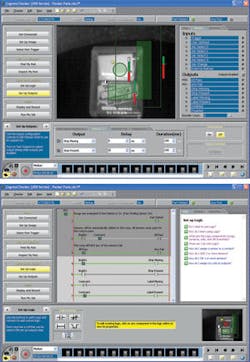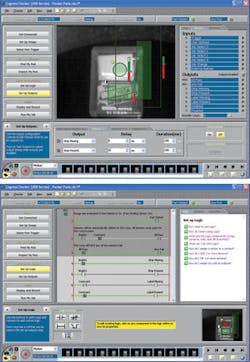Inspection sensors target low-cost vision applications
Andrew Wilson, Editor, [email protected]
Most automated inspection solutions combine photoelectric or laser-based sensors, programmable logic controllers (PLCs) and machine vision systems to perform complete product inspection tasks. The photoelectric sensors and electro-mechanical switches provide the low-level functions to initiate operations such as triggering of machine vision systems and smart cameras to obtain images of the parts being inspected. After inspection, rejection mechanisms, often triggered through PLCs, move the part from the automation line. Producing these systems requires an intimate knowledge of sensors, PLCs, lighting controllers and machine vision hardware and software required to inspect each part.
“In many factory-automation applications where simple presence and absence inspection tasks need to be performed, multiple photoelectric sensors are used to check for the presence of parts and features on parts,” says Justin Testa, senior vice president and group business manager of Cognex (Natick, MA, USA; www.cognex.com). “There is a need to eliminate the complexity of precisely mounting multiple photoelectric sensors and precisely fixturing parts.” To do this, Cognex has developed the Checker 201 and 202 inspection sensors.
Rather than bill the products as vision sensors, smart cameras, or embedded machine-vision systems, the company has chosen to name these products inspection sensors with good reason. Incorporating a 128 x 101 monochrome CMOS imager from Kodak Image Sensors (Rochester, NY, USA; www.kodak.com), a DSP, built-in red-green-cyan LED lighting, and a high-speed 480 Mbit/s USB 2.0 interface, the Checker 200 series inspection sensors can inspect parts at rates of approximately 6000 parts/minute.
The image quality obtainable with the Kodak imager is less than that obtained with higher-resolution vision systems. But in this case, less is more because Checker has been designed to be a sensor and not a machine-vision system.
“The sensors operator interface allows users to check multiple areas within a captured image for brightness, contrast or patterns. Threshold and sensitivity values, designed to operate similarly to the controls on photoelectric sensors, are set with a number of sliders to easily optimize inspection accuracy (see figure). In applications where multiple features must be checked, one Checker can replace multiple photoelectric sensors that require the part be fixtured.
Perhaps more important, images are captured at rates of 575 frames/s, which enables Checker’s built-in “part-finding sensor” to automatically trigger on any feature of a part as it appears in the inspection sensor’s field of view, thereby eliminating the need for a separate trigger sensor. The part-finding sensor uses normalized correlation to compare the features of parts moving through the field of view and enables Checker to detect and check features such as patterns on labels and printed codes.
Checker 202 incorporates a simplified set of ladder logic within the system’s setup interface to customize the results of decision making such as “anding” or “oring.” For example, if a label or strip or safety seal is missing on the part, the system can be configured to reject all or any specific parts based on mission label or safety seal, and then send an output signal to external actuators to move parts into the correct reject bins. This is accomplished directly through the Checker 202’s optoisolated I/O ports and then control an external PLC through an optional I/O box.
Checker also incorporates a film-strip recording capability similar to that used in Apple’s iMovie software. This capability is useful during setup of the Checker sensor and also as a diagnostic tool to see what is happening on the production line. The film-strip tool stores up to 159 images on-board the inspection sensor. When Checker is taken out of run mode, images can be transferred over the unit’s USB interface to a PC for archiving or review purposes.
To allow potential users to evaluate Checker software, the company has produced a simulator version that is downloadable from its Web site at www.cognex.com/checker. At a price of approximately $1500, Checker 201 may be expensive when compared to the photoelectric sensors that it replaces. However, by providing the capability to detect many kinds of features, manufacturer’s can more easily detect and check the quality of parts without using multiple photoelectric sensors.

